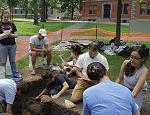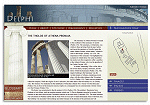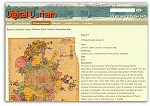Expanding the Canon
Universities are using technology to put undergraduates at the center of content creation.The result: in a word,transformative.
 ORIGINAL RESEARCH AND CONTENT CREATION in the university environment have historically been the domain of faculty and their graduate students. Nowadays, however, undergraduate programs at universities across the country are putting undergrads in the center of the action.
ORIGINAL RESEARCH AND CONTENT CREATION in the university environment have historically been the domain of faculty and their graduate students. Nowadays, however, undergraduate programs at universities across the country are putting undergrads in the center of the action.
Some of these programs-- at Duke University (NC), Coastal Carolina University (SC), Arkansas State University, and Harvard University (MA)-- incorporate interactive technologies to enable undergrads to research local and far-off worlds and create meaningful, original content that furthers the study of their discipline for other students and researchers alike. The content that springs from this research takes the form of high-tech simulations, interactive lesson plans, and history-rich websites for the public.
Overall, the technology behind these programs serves to help these students expand the canon, inspiring a new kind of undergraduate education that is immersive, experiential, and contributive at the same time. The new approaches also have transformed the way humanities traditionally are taught.
"Not too long ago, undergraduate humanities education across academia was based solely on textbooks with pretty photos and the lectures about them," says Bill Barthelmy, senior software architect at Harvard. "With the technologies we have today, to say the times have changed certainly would be an understatement."
Harvard archaeology students incorporate findings from both the archaeological and historical record to build a fact-based model in Second Life.
Unearthing the Past
Along with Katie Vale, director of academic technology, Barthelmy runs the Harvard Yard Archaeology Project, an effort to give students a firsthand understanding of what Harvard Yard (the main campus commons of the university) was like in the 17th century, when the area was home to the first-ever Native American college.
Anthro 1130, also called "The Archaeology of Harvard Yard," is an ongoing course that, over the past several years, has turned Harvard Yard into an archaeological site. In the class, students utilize ground-penetrating radar to determine where in the Yard to dig test pits. Once the pits have been dug, students map each of them with GPS and GIS technology, conduct research about the artifacts they've found, and upload all of the pertinent information to a MySQL database. In particular, the use of the GIS technology has transformed archaeological studies, says Vale.
"Traditionally the way archaeology works is that a dig is scheduled, people uncover things, and over the next year, everyone retreats back to their labs to conduct research and information is slowly analyzed," she explains. "With this, as soon as something is uncovered, you have a way to enter it into the field notes directly," making the knowledge transfer process more efficient.

HARVARD'S GIS iPhone app flags past archaeological finds on a map, enabling students to"experience" the discovery of artifacts.
This past summer, a special pilot program associated with the archaeology class introduced location-aware technology to enable students to "experience" the discovery of the artifacts even if they weren't part of the original dig. Outfitted with an iPhone or iPod Touch loaded with a special GIS application, students walk around the Yard, and as they pass over places where objects were found in previous digs, the handheld app interfaces with Google Earth and the archaeology database to instantaneously display the artifacts, allowing students to "see" the objects where they were found, along with their associated data.
Taking this interaction one step further, students incorporate findings from both the archaeological and historical record and (with faculty supervision) build a fact-based virtual model in Second Life, which allows them to consider and question what the evidence really tells them about life in 17th century Cambridge-- and in some cases, to set the record straight.
Take, for example, the subject of smoking and drinking alcohol. Students building the Second Life model had to incorporate tobacco pipes and a type of bottle that was typically used by early settlers to drink alcohol, both found on the Harvard Indian College campus grounds. An examination of the historical record, however, showed that students at the Indian College were prohibited from drinking and smoking. The incongruence of these findings led students and faculty to explore the idea that the historical record may need to be updated, to suggest that the 17th century "just say no" campaign was not an unqualified success.
At Coastal Carolina University and Arizona State, students' work creating online 3D models of ancient monuments breaks down traditional walls between disciplines and expands the canon for multiple subject areas.
Vale cites this as an example of how the technology gives students who are not a part of an original dig a chance to learn more deeply about the archaeological history of the Yard than even the students who actually found the artifacts. "Without the technologies, without the process of going through and literally analyzing all of these facts, our undergraduates never would have been able to experience these discrepancies for themselves," she says.
It's not just the students who benefit from this project. As Diana Loren, the associate curator for Harvard's Peabody Museum of Archaeology and Ethnology, which houses the unearthed artifacts, states, "Certainly students in this class will benefit the most [from their work], but researchers who teach the course, as well as others, will be able to explore and interact with the data in a completely new way."
The program is not without its challenges. Barthelmy admits that even with student help, he has had to spend a lot of time developing the Second Life model and iPhone app. Coding is a problem as well-- though a handful of students know how to write applications for iPhone and iPod Touch, there is no extracurricular development in these areas.
Still, Barthelmy plans to persevere. Based upon the initial success of the summer handheld pilot, as of press time school officials were expected to fully incorporate the technology into the fall semester's offering of Anthro 1130.
Beyond that, Barthelmy notes, the university may even make the program open to the public. "Our hope is that people will be able to 'dig' a little deeper as time goes on," he says. "No matter what kind of technology is involved, that's the goal at the end of the day."
Discovering Delphi
A collaborative project between Coastal Carolina University and Arkansas State University involves undergraduates in building learning models and interactive lesson plans that cross traditional academic lines and bring together faculty and learners from multiple disciplines.
This project, dubbed Ashes2Art, dates back to 2005. Its original intent was to improve materials available for teaching art and architectural history. The program has moved far beyond its initial objective to merge the pedagogical and research aspects of art history, archaeology, graphic design, web design, 3D animation, and digital photography, to recreate monuments of the ancient past online. Art, graphic design, and art history students from both institutions are enrolled, and the models and lesson plans students create are designed for use in art history, architecture, history, archaeology, and many other studies.
With faculty guidance, students from CCU and ASU conduct focused research on specific monuments, visit the locations in person, shoot high resolution digital panoramas, write essays that summarize scholarly opinions based on published archaeological reports, and document those sources through extended bibliographies. Students also build QuickTime digital panoramas and immersive 3D models of the sites, as well as create and maintain the project website. All of these products are incorporated into student-designed lesson plans that are being actively used by art history and architecture faculty at both universities.
Arne Flaten, associate professor of visual arts at CCU, says that Ashes2Art was inspired by similar graduate and faculty projects at UCLA and other universities, and, "We felt we could get similar results from undergrads if they were given the right tools and proper supervision. We were right."

THE ASHES2ART PROJECT merges the pedagogical and research aspects of art history, archaeology,graphic design, web design, 3D animation, and digital photography, to recreate monuments of the ancient past online.
The first stage of the project focused on Renaissance Florence. While that initial course did not "reconstruct" lost monuments, it provided a context in which to evaluate various technologies and gauge the potential and efficacy of such a program. More recent research involved the archaeological site at Delphi, Greece, which dates back to the fourth century BCE, where a total of 40 students from both schools traveled during the summers of 2007, 2008, and 2009.
"The course originally was designed to blur the lines between what traditionally have been art studio and graphic design and art history, but we've exceeded the expectations of even that," explains Flaten. "Students are not just learning from what their instructors are telling them; they are learning from engaging with site plans and excavation reports and cognitively taking this information and translating it into three-dimensional imagery."
The project's use of various and complex technologies has created its own cross-disciplinary effect at the two universities. Originally students learned the necessary tech skills as part of the course. These technologies include Easypano's Panoweaver and Tourweaver; Autodesk 3ds Max (formerly 3D Studio Max), Stitcher Unlimited (formerly RealViz Stitcher), and Mudbox; Adobe Photoshop, Dreamweaver, and Flash; Google Earth; interactive mapping tools; and others-- a non-trivial list to master.
Since then, program officials have been working with other department heads to set up prerequisite classes in various other departments so that undergraduates already know how to use programs like Autodesk 3ds Max when they get involved with Ashes2Art. According to Flaten, this commitment to incorporating a variety of subject areas only adds to the expanding canon by breaking down traditional walls between disciplines.
"We've got people from computer science and marine science and graphic design and art history-- we're expanding the curriculum by putting people together who might not have necessarily had conversations traditionally," he says.
He adds that "When you can take your classroom from lecture to lab experience, it changes the traditional methodology of teaching and turns it into more of a heuristic approach."
While Ashes2Art is still under development, the program hopes to eventually incorporate sites elsewhere in Europe, or colonial plantations and the Gullah people of Sandy Island, SC. Until then, Flaten notes, the biggest challenge of the program is funding. Ashes2Art had been funded by the National Endowment for the Humanities, but that funding has just about run out. What's more, CCU and ASU were paying to send students abroad, but in the current economy, those expenditures have come under increased scrutiny as well. To resolve these problems, program officials have applied for additional grants.
"We'll keep this going no matter what," Flaten says. "Money is important, but to me the bigger issues are content, research, and technology."
Recreating the Post-bellum South
Late 19th century Durham, NC, has long been recognized by historians as a symbol of the New South, dubbed, for example, by Booker T. Washington as a "City of Negro Enterprises." Undergraduates at Durham-based Duke University are using a mix of primary research and technology to gain-- and disseminate-- a better understanding of emancipation, industrialization, immigration, and urbanization that lie at the heart of Durham's special place in history.
This project, dubbed Digital Durham, is a website that offers students, teachers, and researchers a range of primary sources with which they can investigate the economic, social, cultural, and political history of a post-bellum Southern community. Most of the sources have been uncovered by undergraduates; all sources have been digitized and entered into a database by the same group.
Taken together, the materials on Digital Durham cover more than 600 topics, including: African-American business enterprise, the emergence of textiles, tobacco production and marketing, child labor, prohibition, evangelical revivalism, 19th century medical practices, women's experience of childbirth, and public and private education. "This is arguably the single most comprehensive set of resources about late 19th century Durham that exists today," says Trudi Abel, the project's director. "Aside from some faculty advisers, students are behind all of it."

BY FINDING AND DIGITIZING historical documents for the Digital Durham project, Duke students experience the joy and challenges of doing original historical work.
In particular, Abel says undergraduates have helped her aggregate data from the 1880 census. These data have been available to the public since the 1950s, but have been trapped on microfilm so very few people have bothered to access them. At Duke, students review the microfilm, transcribe the data, put the data into a spreadsheet, and migrate them into an SQL database, which is where they live online. Also online are audio postcards-- podcasts of oral histories and other recordings-- created by Duke students in an undergraduate research seminar on the history of Durham and the New South.
As part of the project, undergraduates are encouraged to search for primary source material themselves. Common places students look include on-campus libraries, the county courthouse, and public libraries. In some cases, students have uncovered material that nobody discovered previously.
Last year, for example, one student dug up a copy of a 19th century journal called the Journal of Industry, edited by Charles Hunter-- a publication that Abel later determined to be one of the few surviving copies of the newspaper.
The Digital Durham website offers students, teachers, and researchers a range of primary sources with which they can investigate the history of a post-bellum Southern community.
Today, a digital copy of the journal exists under "Printed Works" on the Digital Durham website and contains the text of a speech by Frederick Douglass given in Raleigh at the time. Abel says the process of finding the paper and digitizing it made the student feel like she was contributing to the body of historical evidence.
"When students are doing their own research, they design it so it's of intrinsic interest," notes Abel, a scholar in residence in Duke's history department. "They're using the same kinds of raw materials that a historian or scholar would use and they get to experience the joy and the frustration of doing that kind of fresh and original historical work."
Down the road, Abel hopes to expand the Digital Durham project to incorporate an interactive map that would reveal to visitors the names and occupations of people living in Durham in the 1880s. On the surface, she says, this map will provide visitors with cursory data on the 4,000 people who called the city home way back when. More profoundly, however, if she can get the map to sync up with a map of Durham today, the endeavor could provide a cornucopia of information about Durham as it survived industrialization.
"If you look to see where the [minor league baseball team] Durham Bulls play today, you'd learn that the first graded school for African-American students sat out in left field," she says. "That's incredibly important in the history of public education in our town, tying into questions about access to education, segregation, and the progressive movement."
She concludes: "Being able to see the two [maps] at once would give students the ability to see history in layers. That's what this entire project is about."
::WEBEXTRAS ::
Head to our Learning Resourcessolution center for the latest news,case studies, research, features,and more.